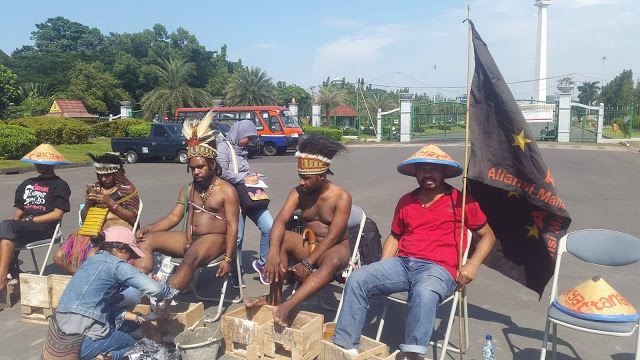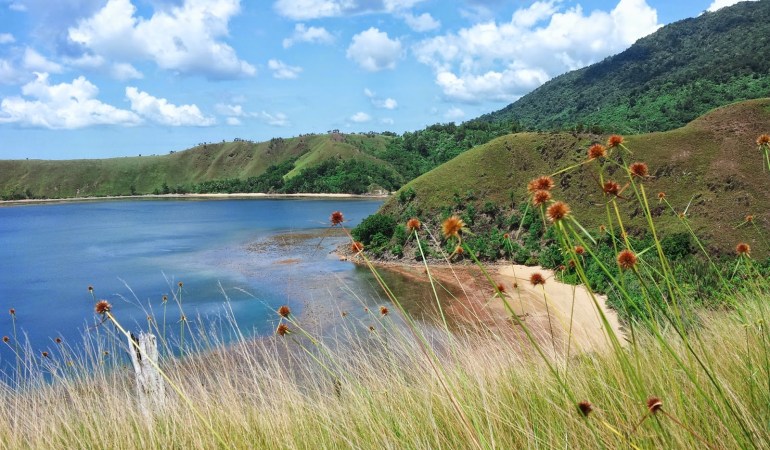The Radar Sorong newspaper, on 19th April 2017, published a story about the Environment and Forestry Minister signing an agreement to change the land use designation an area of protected forest in Gunung Botak (bald mountain), Momiwaren sub-district, South Manokwari Regency, West Papua province.
According to the head of the Papua Barat Province Forestry Agency, Hendrik Runaweri, the local government recommended a change of land use designation, where 2000 hectares of protected forest around Gunung Botak would be classified as production forest, and the minister agreed to 40 hectares. It was also reported that this protected forest had its status changed to accommodate the interests of PT SDIC Papua Cement Indonesia, which has a cement works in Maruni, Manokwari Regency, West Papua Province, as a source of raw materials for cement production.
No information is yet available about how the local government or the minister managed to fulfill various conditions and procedures needed to change the land use classification of the forest, such as a study by an integrated team, a study of impacts and an agreement on boundaries involving local communities. Because of this, opinions have been voiced that the government has neglected to carry out these steps and has been overly accommodating to corporate interests.
In 2014, the Environment and Forestry Minister (at that time still just the Forestry Minister), issued decree SK710 about changes of use and function of the forest estate, and land being excluded from the forest estate, which included classifying Gunung Botak in Momiwaren sub-district as an area of protected forest. According to the Strategic Environmental Review in the Papua Barat Provincial Spatial Plan (2013), Gunung Botak is a hilly and mountainous karst area, and also a zone with a risk of disaster. In accordance with the Ministerial Regulation 17/2012 from the Energy and Mineral Resource ministry which establishes Karst Landscapes, this area of state forest should ideally be maintained with a classification of protected forest.
The Government policy to change the land use and issue a permit to exchange the forest area also disregards the land rights of the local indigenous communities and their right to participation. Community leaders and clans who claim ownership of the land, the Sayori, Ainusi, Tirirbo and Mukiri clans living in and around Siep, Yekwandi and Mawi village, have said that there has still not been any decision-making meetings with the government and companies to discuss the use of the Gunung Botak area. (Further reading (Indonesian): PT SPCI Membohongi Masyarakat Adat Pemilik Gunung Botak)
The local community explained the mythology of Gunung Botak as it related to their cultural identity and ancestors, such as the story of the Yaimeki cave or source. This is also their source of food and water catchment. This sort of knowledge and value is rarely considered when making decisions about development projects.
The government is using the pretext that the extraction of quartz sand from Gunung Botak would reduce the price of the Conch brand cement SDIC produces which currently costs 57,000 Rupiah per sack on the local market. Quartz sand is currently being brought from Kalimantan, which increases the price. However, the strange thing is, Conch cement produced in Manokwari is being sold in Tual (Maluku) at 46,000 Rupiah per sack.
This sort of change in policy which only takes into account the group’s interests and is based solely on a cost-benefit economic analysis will only bring conflict, injustice and discrimination, to the benefit of certain groups and individuals.
The controversy around SDIC Papua.
The PT SDIC Papua Indonesia cement company is a collaboration between a Chinese state-owned company, SDIC (State Development and Investment Corp) and Anhui Conch Group, which was signed on 25th September 2014. The brand of cement the company produces is called Conch. Apart from Maruni, Papua. the Conch cement company also has operations in Tabalong, South Kalimantan, Maros, South Sulawesi and Merak, Banten. It has 200 factories throughout the world with a production capacity of 300 million tonnes per year.
Since the beginning, the creation of the Conch cement factory has invited problems due to the land issue, and how profits from the use of raw materials for cement are shared with the local indigenous community. In news from early January 2017, it was reported that local indigenous people were still blockading the entrance gate to the cement works, demanding the payment of land compensation.
The cement factory is located in an area dotted with villages and people who live around the Maruni River, and therefore it is sure that it will impact or reduce the quality of the environment, or have other social impacts. Because of this the Papua Barat Indigenous Peoples’ Association (LMA) has urged the government and company to explain the impacts and how the environmental change caused by the company’s activities will be managed.
Another of PT SDIC’s contradictions concerns labour issues. The company is using workers from China, which do not have full legal documents. However, the government has already taken action to send these illegal workers home. The company has also reduced workers’ pay by 200,000 Rupiah and so it does not match with the sum written on their payslips. This has triggered a strike amongst the workers.
Source: Pusaka http://pusaka.or.id/kepentingan-korporasi-dibalik-alih-fungsi-hutan/
More cement news:
 The cement industry continues to destroy karst areas around Indonesia. In other recent news relating to cement, on 27th March 2017 Papuan students joined an action in solidarity with the farmers around the Kendeng hills in Central Java who are resisting a cement works owned by another cement company, PT Semen Indonesia. The action participants concreted their feet into boxes near the National Monument in Jayapura. However, while it faces resistance in Java, PT Semen Indonesia has contracted a company, PT Mineral Jaya Mining, to help seek out a location in Jayapura, Papua for a new cement factory there. Two planned industrial developments in the area, Depapre container port and Bonggrang industrial area are expected to be major custormers.
The cement industry continues to destroy karst areas around Indonesia. In other recent news relating to cement, on 27th March 2017 Papuan students joined an action in solidarity with the farmers around the Kendeng hills in Central Java who are resisting a cement works owned by another cement company, PT Semen Indonesia. The action participants concreted their feet into boxes near the National Monument in Jayapura. However, while it faces resistance in Java, PT Semen Indonesia has contracted a company, PT Mineral Jaya Mining, to help seek out a location in Jayapura, Papua for a new cement factory there. Two planned industrial developments in the area, Depapre container port and Bonggrang industrial area are expected to be major custormers.

